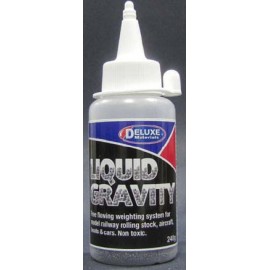Static grass puffer bottles work by manually charging model grass fibres with static electricity. When the charged...
No products
Product successfully added to your shopping cart
There are 0 items in your cart. There is 1 item in your cart.
Search Tips
How can I add a measured amount of weight to my rolling stock?
There are a number of ways to add weight to rolling stock so that it will better handle the track and is less likely to derail.
One of the key issues is not to add too much weight. If a wagon is too heavy it may create too high a load for the motor in the locomotive to handle, this can also lead to the wheels of the locomotive being unable to maintain traction with the track. It is worth spending a little time experimenting to determine the optimal weight for any given wagon. This will allow the wagons to better handle the track but will avoid excessive strain on the Locomotive motor.
One product that can assist with this is Deluxe Materials Liquid Gravity. This consists of very small steel balls that can be poured into a suitable receptacle to create weight. The subsequent ballast will self-level due to the small size of the ballast components and can be easily secured in place by a variety of adhesives such as Epoxy or PVA.
The advantage of liquid gravity is that the modeller can carefully measure the required weight of ballast and carefully distribute it to ensure an even load over the axles.
Click here to receive the tips weekly in your mailbox. You can unsubscribe at any time.








